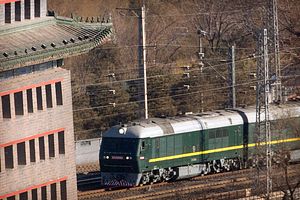North Korean leader Kim Jong Un took a train from Pyongyang to Vietnam and back for his summit with U.S. President Donald Trump. Traveling through China for 60 hours each way, Kim’s train was spotted in Zhengzhou, Henan province, and then later in Wuhan, Hubei province, where it would have crossed the Yangtze River.
Progressing slowly, some said at no more than 60 kilometers an hour, Kim had an opportunity to take visual stock of the results of China’s market reforms, the same type of reforms that the American president is encouraging Kim to embark upon. However, from the bleak landscapes of Henan province to the polluted city centers of urban China, Kim’s trip could have given him cause to think again about the economic measures he is being told will make his country rich.
Visually, China’s economic “miracle” fails to be impressive once one goes too far outside of major city centers. True, train routes worldwide often travel through aging industrial zones and older, rundown neighborhoods no matter the country or continent.
But in China, the residential, business, and industrial developments that Kim’s journey will have taken him near are relatively new. Most have been built within the last 15 to 20 years. Because of this, nothing shows the stark price that China has paid for its lightning fast progression from farms to factories and beyond as clearly as a train trip between its cities.
Kim will have seen, for example, block after block of hastily constructed high-rise apartment buildings that haphazardly ring the outskirts of cities along his train route. Lacking cohesive planning and fueled by insider developer deals using close government ties, this construction frenzy has resulted in some of the worst urban planning aesthetics of any cities in the world. Ultimately, cohesive design of these developments became a secondary concern to getting them built and deriving value from their sale.
Crucial for Kim to consider is how his country can develop industrially and technologically, while at the same time protecting and improving his food supply. China’s answer to that same problem is evident as one traverses the country by train. Kim cannot help but have seen that China’s explosive construction has come at the expense of one of its scarcest resources: arable land.
Government land grabs have decimated rural farming communities throughout China, upending traditional life and neighborhoods for millions of China’s farming residents. More critically, however, the size of China’s farmland has been reduced through conversion to development projects, and by severe pollution. China, once self-sufficient in food, now imports it from all over the world, often from foreign land which its companies have bought outright.
As Bloomberg reported in 2017:
China lost 6.2 percent of its farmland between 1997 and 2008, according to a report by the United Nations’ Food and Agriculture Organization and the OECD. And local governments continue to swallow fields for more-profitable real-estate developments… More alarming for the nation’s planners are reports that almost 20 percent of China’s remaining arable land is contaminated.
If developing one’s economy comes at the expense of being self-sufficient in feeding one’s people, Kim has had a perfect example of that on his train rides through China. North Korea itself has only 17 percent of its own land under cultivation, according to a World Food Program report.
Kim will also have been able to see Chinese village upon village in which living conditions are still basic and largely unimproved, despite capitalism “with Chinese characteristics” reshaping the country. In the fields and in the dirt roads of these villages are people who still live without indoor plumbing to either remove waste or provide water for boiling, drinking, cooking, and bathing. Indeed, estimates are that from one-fourth to one-third of the population of China has no piped water.
One wonders if this might be a surprise to Kim. After all, he has been to Beijing and to Dalian, and has therefore encountered what reforms have meant for Chinese living in major urban areas. And while U.S. President Donald Trump and others have a vision for Kim and his country as an economy that could be as dynamic as Vietnam’s, China’s, or Singapore’s, Kim will have been able to see for himself as he rolls through the Chinese countryside that the results of reforms in China have left the country utterly lopsided, with millions upon millions living in conditions not too short of despair, while millions of others live in comfort and often excess.
What does that say about the appeal of market reforms for Kim, a man who clearly wants to improve his country while at the same keeping control of it? If he unleashes the potential of his people by opening up to foreign investment and involvement in his economy, how many are going to be left behind, as he can see in China, and how will they react?
For Kim may also know that his train trip through China brings him close to areas that have seen significant labor and other protests, numbering in the thousands each year, which beleaguer the Chinese authorities. Though little-reported inside of China, government figures cited 87,000 “mass incidents” in the last year for which official figures are available. In the intervening 12 years, observers and researchers say that the number has only grown.
Part and parcel of a nation’s development are the winners and losers who are created along the way. How prepared is Kim to deal with civil unrest at home, if he decides to take the plunge into the kind of market reforms he has just seen evidence of throughout China?

































